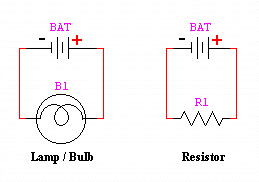 |
|
|
|
|
|||||||||
|
If we take a light bulb and connect it to a battery, the bulb will light up. The lamp lights up because current flows through it. The current leaves the battery at the negative terminal, flows through the bulb, and returns to the positive terminal of the battery. The electrons flow in one direction. This is known in electronics as DIRECT CURRENT flow because the electrons flow only in one direction. The arrows in the figure show the direction that the current would flow in this circuit. As long as we can follow the current from the negative terminal of the battery throughout the entire circuit, and back to the positive terminal, we have a COMPLETE CIRCUIT PATH. It is very important to remember that current will ONLY flow if the circuit path is complete. If we were to remove the light bulb from the circuit, the circuit path would not be complete, and while voltage would still exist on the battery, no current would flow through the circuit. In order to have any complete circuit, you are required to have at least 3 parts: (1) The SOURCE or SUPPLY of Voltage. (2) The LOAD which uses the source Voltage. (3) A complete path of connecting wires. |
|
| ||||||||||||
|
Remember that a resistor is any device which causes electrical friction. In electronics, the resistor can be substituted for any current load. The schematic symbol for a battery can likewise be substituted for any direct current supply voltage. So, in essence, we could theoretically use our battery and resistor to represent our light bulb circuit. |
 |
|
You will notice that the picture on the left is the same one we just looked at. The one on the right actually has two schematic diagrams. The schematic on the left is an exact representation of the picture on the left. The schematic on the right we say is an ELECTRICAL EQUIVILANT circuit for the one on the left. Any circuit, no matter how complex, can be broken down to being a source and a load. The resistor represents the light bulb, which is the load of the circuit. Anytime you are having a problem figuring out how a circuit works, it can be helpful to break it down to an ELECTRICAL EQUIVILANT circuit. The SCHEMATIC SYMBOL for the light bulb is pretty self explanatory. The Schematic for the resistor looks like a series of sharp turns. Just remember that on a road, you have to slow down at sharp turns, and electrical flow (current) has to slow down at a resistor. The battery needs a little explanation. The lines represent the electrodes of a battery. Note that the SHORT line is always the NEGATIVE terminal, and the longer line is always the POSITIVE terminal. |
||